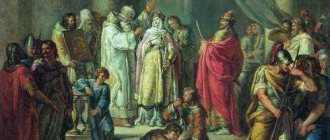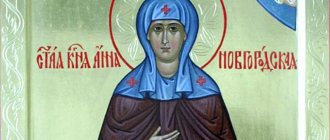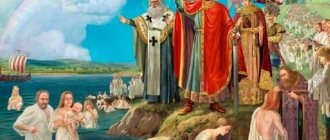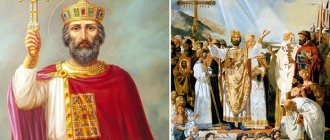The future painter and academician Ivan Akimov was not yet 10 years old when, having become an orphan, he wrote a letter to the Academy of Arts, attached drawings and asked to take him to study at public expense. He studied successfully, received an education, went on a trip to Europe, returned to Russia, continued writing and became a teacher at the same imperial academy, which he later headed for several years. In his old age, he devoted most of his time to his students, and after his death, he transferred everything he had acquired and earned to the academy, to support low-income students.
Hagia Sophia is one of the masterpieces of Byzantine architects, built by order of Emperor Justinian I in the 6th century. The new temple was supposed to surpass all buildings built up to that time in the world. The work took 5 years, tens of thousands of workers were involved, and the costs seemed to be comparable to the annual state budget. After the fall of Constantinople in 1453, the cathedral, by the will of Sultan Mehmed II, was transformed into a mosque, and minarets were added to it. Now the architectural complex has been turned into a museum; services are not held there.
“The Baptism of Princess Olga,” 1792. I. A. Akimov. Source: wikimedia.org
Fabulous story of the chronicle
The ancient Russian Tale of Bygone Years reports about Olga’s baptism in Constantinople. Moreover, he calls her the godfather of Emperor Constantine VII Porphyrogenitus himself.
According to the chronicle, in 955 Olga visited Constantinople, as we would now say, on an official visit. The emperor talked with her a lot, was admired by her intelligence and beauty and proposed to her. To which Olga replied that, according to Greek customs, it is not appropriate for Christians to marry pagan women. And she offered to baptize her.
The baptismal ceremony was performed personally by Patriarch Theophylact, and Constantine was the recipient from the font. Olga became Elena in baptism. After the ceremony, the emperor repeated his marriage proposal. Then Olga-Elena reminded him that godparents should not marry their godchildren. It was then that Konstantin realized how Olga had tricked him.
Beginning of reforms
Even before her baptism, the princess began reforms in the management of the principality. She forbade tax collectors from taking “three skins” from their subjects. Until this time, no one kept strict records of tax collection, and tipsy princely “publicans” could rip off the same tax twice from the same courtyard.
Olga introduced strict accounting, divided the principality into sections, and in each one she built a graveyard - a fortress where taxes were taken, and where, obviously, the accountants were located. Later, Orthodox churches began to be built on the territories of the fortresses, and the word graveyard was assigned to cemeteries where Christians were buried.
Testimony of the Byzantine Emperor
It’s funny to read the fiction of a later chronicler, according to which the newly baptized Russian princess appears to be a better expert in canonical church law than the sovereign of the Orthodox empire, and, moreover, who wrote the treatise “On Ceremonies” in Byzantium. No less funny is the matchmaking of the married Konstantin to the dowager princess of the Rus, who at that time, according to the same chronicle, was 62 years old.
For clarification of the circumstances, it is advisable to turn to the testimony of the same Constantine. He describes Olga's visit in the book "On Ceremonies." According to the exact calendar dates he named, this event occurred not in 955, but in 957. The Emperor, so pedantic in his presentation of court rituals, says nothing about Olga’s baptism. But the adoption of Christianity by the ruler of a neighboring “barbarian” country has always been a huge event in the politics of Byzantium. From that moment on, such a country was considered included in the circle of civilized states as a vassal of the Byzantine Empire.
If such an event had taken place under Constantine, and even with his participation, then he would certainly have mentioned it. But he only talks about the reception and celebrations on this occasion. He also reports that in Olga’s retinue there was a priest named Gregory, without, however, revealing his origin. It is important that Konstantin everywhere calls Olga by her pagan name and never mentions her Christian name Elena.
The obvious conclusion from this testimony is that at the time of her visit to Constantinople in 957, Olga had not yet been baptized.
Death
Olga died of illness and old age, and was not killed, like many rulers of that time. The chronicles indicate that the princess died in 969. In 968, the Pechenegs raided Russian lands for the first time, and Svyatoslav went to war. Princess Olga and her grandchildren locked themselves in Kyiv. When the son returned from the war, he lifted the siege and wanted to immediately leave the city.
Monument to Princess Olga in Kyiv
His mother stopped him, warning him that she was very ill and felt her own death approaching. She turned out to be right; 3 days after these words, Princess Olga died. She was buried according to Christian customs, in the ground.
In 1007, the grandson of the princess, Vladimir I Svyatoslavich, transferred the relics of all the saints, including the remains of Olga, to the Church of the Holy Mother of God in Kyiv, which he founded. The official canonization of the princess took place in the middle of the 13th century, although miracles were attributed to her relics long before that, she was revered as a saint and called equal to the apostles.
Olga's request to German Catholics
In 959, the “Queen of the Rugs” Helen, as she is called in the German “Chronicle of the successor of Reginon,” turned to the German Emperor Otto I with a request to send a prelate and clergy to Rus' for instruction in the Christian faith and the organization of church affairs. In 961, Bishop Adalbert of Magdeburg arrived in Kyiv with a large retinue and began to organize the Russian Church. However, something didn’t work out for him, since the next year he had to flee back to Germany along with his assistants.
All sorts of reasons can be assumed for the conflict. This could also be a reaction of the population, pagan for the most part, to the German methods of inculcating Christianity. It could also be that those around Olga gained the upper hand in favor of orientation towards Constantinople. But there is no doubt that for teachers of the faith, just two years after her visit to Constantinople, Olga turned not to the Orthodox Church, but to the Catholic Church. True, the split in Christianity at that time was not yet finalized.
Before Prince Vladimir
Kievan Rus does not need to be represented as some kind of little world “behind the Iron Curtain”. It was an ordinary Eastern European medieval state. Pagan cults coexisted with Christianity in it. In any case, this is what archaeological finds indicate. The first Christian churches, of which nothing remained except the foundations, existed in all major cities of that time, including Kiev and Novgorod: And if there were churches, then there were parishioners. Otherwise, why build a church? But these churches were most likely not entirely correct from the point of view of official Orthodoxy. They were of the Aryan persuasion, since the first Christianity came to Rus' from Bulgaria. Arianism in Constantinople was considered a heretical doctrine. Otherwise, why would the existing Christian churches in Kyiv, after universal baptism, have to be re-consecrated by clergy who arrived from Byzantium? After her “alleged baptism in Constantinople itself,” Olga built several new churches. And they also had to be rededicated. During the time of Constantine, it was believed that Orthodox churches did not exist in the Kiev state. The Romans did not send their priests to Rus'. On the contrary, the Kyiv land in Byzantium was considered “evil in our faith,” in contrast to the “filthy lands” where real pagans lived. But where would Bulgarian Arianism come from in Rus'?
Baptism in Kyiv in 957-958.
The “Chronicle of the Successor of Reginon” and later Byzantine sources speak of Olga’s baptism in Constantinople under Constantine VII. Probably, a certain tradition was established, according to which it was advantageous to believe that the Russian princess accepted Christianity exactly there and then.
It is clear why the German chronicler (it is assumed that he was Adalbert himself) preferred to claim that Olga was baptized in Constantinople by the emperor. It seemed honorable to wrest the ruler of a huge country from the Orthodox Church to the Catholic side. It is no less clear that in the 11th century, after the baptism of Prince Vladimir, Byzantine historians also wanted to believe that Olga accepted Christianity from the hands of the basileus. After all, in this way the idea was implanted about the long-standing orientation of Rus' towards Byzantium and the original dependence of the Russian Church on the Constantinople.
But, taking into account the evidence of contemporary sources, Olga was most likely baptized between October 957, when she left Constantinople, while still a pagan, and 959, when she, as a Christian, Elena turned to the German emperor.
Most likely, the baptism took place in Kyiv, where there were Christian communities before. The cleric Gregory, who was with Olga in Constantinople, could have been involved in the baptism. Considering Olga-Elena's request to Otto I, the Russian princess considered herself no more connected with the Orthodox Church than with the Catholic Church. Or rather, she had not yet chosen which ecclesiastical and political center of the world of that time she should better focus on.
Life of a princess
The future saint and grand duchess was born around 890. Her name - Olga - was the Russian version of the Scandinavian name Helga, which translates as “bright”, “sacred”. She was a simple, unfamous girl, although she came from a forgotten family of Izborsk princes.
Princess Olga's husband was Prince Igor of Kiev, whom she accidentally met on the banks of a river in the Pskov land. Princess Olga ascended the Kiev throne after Prince Igor was killed by the Drevlyans. She ruled for seventeen years - from 945 to 962. Olga had a son - Grand Duke Svyatoslav Igorevich.
Baptism of Rus'
Kievan Rus became Christian on August 988.
Internally, spiritually, with all her essence, she was ready to accept Orthodoxy, and the seed of Christianity fell on fertile soil. Russian people with fear and faith plunged into the sacred waters of Khreshchatyk, Pochayna and Dnieper to receive holy baptism. These days mark 1020 years since the baptism of Kievan Rus, which made a conscious and final choice of faith, moving from paganism to Christianity. The first enlighteners
Paganism is a pre-Christian religion, polytheism, polytheism, when people worshiped idols. The main ones in ancient Rus' were the Sun (Dazh Bog) and Thunder and lightning (Perun). Many lower idols were also revered - patrons of the economy, home, land, water, forest, etc. In the life of our pagan ancestors there were many superstitions, cruel customs, and even human sacrifices occurred. At the same time, paganism in ancient Rus' did not delve into idolatry to such an extent as to have idol temples and a caste of priests.
Already in the first century AD. Eastern Slavs (Polyans, Drevlyans, Dregovichs, Buzhans, Slovenians, Ulichs, Vyatichi, Tivertsy) gradually began to realize the need to choose Christianity as the true faith, which began to penetrate into the territory of future Rus'. According to legend, at the beginning of the 1st century AD. The Eastern Slavs were visited and the beginning of Christianity was laid here by the holy Apostle Andrew the First-Called. For his god-creating activities, by the lot of the apostles in Jerusalem, he received Scythia - the territory north of the Black Sea and to the Baltic. Arriving in Chersonesos (a Greek colony in Crimea, in the 4th-10th centuries it depended on Byzantium), the Apostle Andrew founded the first Christian community here and built a temple.
According to the ancient Greek chronicles, from Chersonesos the Apostle Andrew came to the mouth of the Dnieper and ascended to the Middle Dnieper region. At the foot of the Kyiv Mountains, where there were then several clearing settlements, he prophetically said to his disciples: “Do you see these mountains? On these mountains the grace of God will shine, there will be a great city...” “And having ascended these mountains,” the chronicler narrates, “he blessed them and put a cross here... and, descending from this mountain, where Kiev later arose, he went up the Dnieper. And he came to the Slavs, where Novgorod is now, and saw the people living there..."
As evidenced by the latest historical research, from Novgorod along the Volkhov River, Apostle Andrei swam to Lake Ladoga, and then to Valaam. He blessed the mountains there with a stone cross and converted the pagans living on the island to the true faith. This is mentioned in the oldest manuscript “Rebuke”, kept in the library of the Valaam Monastery, and in another ancient monument “Vseletnik” by Kyiv Metropolitan Hilarion (1051).
The continuator of the evangelistic labors of the Apostle Andrew in the Black Sea region was the Hieromartyr Clement, Bishop of Rome. Exiled by the Roman Emperor Troyan to Chersonesus, for three years (99-101) he spiritually cared for more than two thousand Crimean Christians here. Saint John Chrysostom, who was serving exile in one of the cities of Abkhazia in the 5th century, also carried out preaching activities. All their activities served to gradually spread Orthodoxy throughout the Crimea, the Caucasus and the entire Black Sea region.
The first enlighteners of the Slavs, the holy Equal-to-the-Apostles brothers Cyril and Methodius, also took part in the baptism of Rus'. They compiled Slavic writing (the exact date of the brothers’ creation of the Slavic alphabet and the foundations of writing is given by the authoritative source “On Writing” by Chernorizets Khrabra - 855), translated the Holy Scriptures and church books into the Slavic language. In 861, the brothers arrived in Tauride Chersonesus and baptized two hundred people here at once. They also visited the ancient territory of what is now Transcarpathia, where the Rusyns were baptized, and Saint Methodius even lived for some time in the local monastery in the settlement of Grushevo.
Askold and Dir
The entire history of the adoption of Christianity in Rus' was directly related to the process of formation of the Orthodox Church itself, completed only in 842 with the establishment at the Local Council of Constantinople in Byzantium of a special celebration - the Triumph of Orthodoxy.
According to Greek sources, the Kyiv princes Askold and Dir were the first to be baptized in ancient Rus' and convert to Orthodoxy in 867. They came to Kyiv with fighting squads in the middle of the 9th century. from the north, where the tribes of the Slavs (Slovenians and Krivichi together with the Finnish tribes) created a strong state formation centered in the city of Ladoga, located at the mouth of the Volkhov River, which flows into Lake Ladoga. This formation arose after the Khazars’ invasion of Southern and Central Rus' (the most likely date of the Khazars’ invasion of Kyiv is around 825).
The baptism of the Kyiv princes is described as follows. According to the testimony of the Patriarch of Constantinople Photius, in June 860, two hundred Russian ships, led by Askold and Dir, attacked Constantinople, which “almost was raised on a spear,” and that “it was easy for the Russians to take it, but impossible for the inhabitants to defend it.” But the incredible happened: the attackers suddenly began to retreat, and the city was saved from destruction. The reason for the retreat was a sudden storm that scattered the attacking fleet. This spontaneous dashing was perceived by the Russians as a manifestation of divine Christian power, which gave rise to a desire to join the Orthodox faith.
After what happened, the Byzantine Emperor Macedonian concluded a peace treaty with the Russians and “arranged for them to accept Bishop Michael, who was sent to Rus' by Patriarch Photius of Constantinople to spread the Orthodox faith.” The God-creating activity of Bishop Michael yielded results - princes Askold and Dir with the “Bolyars”, elders and part of the people in Kyiv were baptized. Patriarch Photius wrote on this occasion: “And now even they have exchanged the wicked teaching that they previously held for the pure and genuine Christian faith, lovingly placing themselves in the rank of subjects and friends, instead of robbing us and the great insolence against us that had not long ago."
This is how the first mass baptism took place in Rus'. The first all-Russian prince, a Christian Askold, received the name Nicholas, in honor of St. Nicholas the Wonderworker. In 867, the first Christian community, headed by a bishop, appeared in Rus'.
The spread of Christianity in Rus' already in the 9th century. confirmed by Arabic sources. In the “Book of Ways and Countries” by the outstanding geographer Ibn Hardadweh, with reference to data from the 880s, it is said: “If we talk about the merchants of ar-Rus, then this is one of the varieties of Slavs... They claim that they are Christians...” At the same time, the introduction of ancient Russian people's approach to Christianity was not widespread and strong at that time. The actual baptism of Rus' took place only more than a century later.
Oleg and Igor
In the second half of the 9th century. a significant part of the Eastern Slavs (Polyans, Rodimichs, Krivichis, Severians, Dregovichi, Novgorod Slovenes) were united under the rule of Prince Oleg of Ladoga (princely reigned around 879 - early 10th century). He came with his squad from Novgorod (the Novgorodians, back in 862, having united the north-eastern Slavic tribes, drove the Varangians overseas “and if you didn’t give them tribute, you would often lose yourselves”), captured Kiev (around 882) and killed Askold and Dir, who reigned there. By uniting Novgorod with Kiev, Prince Oleg laid the foundation for Kievan Rus and continued the liberation of the southeastern tribes from the Khazar Khaganate.
The time of his reign was a period of further spread and strengthening of Christianity. It is known from the chronicle that it was under Oleg that a special Russian diocese was created under the authority of the Greek patriarch, and soon the Christian bishopric in Rus' grew into a metropolitanate. At the end of the 9th - beginning of the 10th centuries. The Russian diocese is already included in the lists of Greek bishops.
When in 907 Oleg’s army made a successful campaign against Constantinople, Byzantium was forced to sign a peace treaty beneficial for the Old Russian state. According to the chronicle, the Byzantine emperor invited Oleg’s ambassadors to Constantinople, “sent his husbands to them to show them the church beauty, the golden chambers and the wealth stored in them, teaching them his faith and showing them the true faith.” Upon the return of the ambassadors to Kyiv, the population of the city swore allegiance to the treaty as follows: the pagans took the oath at the idol of Perun, and the Christians - “in the church of St. Elias, which stands above the Brook.”
At the beginning of the 10th century. Oleg's nephew Igor (prince at the beginning of the 10th century - 945) becomes the prince of Kyiv. Fighting to strengthen the Black Sea trade route, he made new campaigns against Constantinople in 941 and 944. Chronicle sources indicate that under Igor there were already a significant number of Christians in Rus'. So, if in Oleg’s treaty with Byzantium only Byzantines are called “Christians,” then in Igor’s treaty, Russians are divided into two “categories”: those who were baptized, and those who were not baptized, worship Perun - “let our Russian Christians swear by their faith, and non-Christians according to their law.”
When the peace treaty between Constantinople and Prince Igor was concluded in 944, obviously people in power in Kyiv were aware of the historical necessity of introducing Rus' to Orthodox culture. However, Prince Igor himself was unable to overcome his attachment to paganism and sealed the agreement according to pagan custom - with an oath on swords. In addition to pagan Russians, Christian Russians also participated in negotiations with the Greeks in 944. Compiled by experienced Byzantine diplomats, this agreement provided for mutual assistance and the possibility of adoption of Christianity by the princes who remained during the negotiations in Kyiv. The final formula read: “And whoever transgresses from our country, whether a prince or someone else, whether baptized or unbaptized, may they have no help from God...”, the one who violated the agreement “may he be cursed by God and by Perun.” However, Byzantium's hopes for the imminent baptism of Rus' did not materialize. The adoption of Christianity turned out to be a longer process for the Russians.
Duchess Olga
In 945, Prince Igor was killed by rebel pagans in the Drevlyansky land, and Igor’s widow, Grand Duchess Olga (principal 945 - 969), assumed the burden of public service. Contrary to the artificial version of the “Normanists” about her Norman origin and today’s “Orangeists” about her Ukrainian “descent”, Princess Olga is a native of the village of Lybuty in the Pskov land, the daughter of a ferryman across the Velikaya River. She was an intelligent woman and a wonderful ruler, a worthy successor to the work of the Russian princes, who earned the recognition and love of the people, who called her wise.
Princess Olga was the first of the Kyiv princes to convert to Orthodoxy directly in Constantinople. According to the chronicle, in the second half of the 50s of the 10th century. “Olga went to the Greek land and came to Constantinople.” She must have been between 28 and 32 years old at the time. When Olga met the Byzantine Emperor Constantine, he, seeing “that she was very beautiful in both face and mind,” said to her: “You are worthy to reign with us in our capital! Olga, understanding the meaning of this sentence, answered the emperor: “I am a pagan; If you want to baptize me, then baptize yourself, otherwise I will not be baptized.”
The political duel began between Olga and Konstantin even before their personal meeting. The princess sought recognition of the high prestige of the Russian state and her personally as its ruler. She lived in the harbor of Constantinople for more than a month before her reception took place in the palace: there were long negotiations about how and with what ceremonies the Russian princess should be received. Wise Olga decided to accept baptism in Constantinople and from the patriarch himself in order to achieve widespread recognition of Rus' in the world of powerful Christian states and to ensure the spiritual support of the Ecumenical Patriarch for his own apostolic mission on Russian soil. And the princess achieved extremely important results. She was baptized with honors in the capital of Byzantium, in the Church of St. Sophia - the main cathedral church of the Ecumenical Church of that time. At baptism, Olga received the name Helena (in honor of the mother of Constantine the Great) and a blessing for an apostolic mission in her country.
After baptism, Emperor Constantine again met with Olga on October 18, 957 and told her: “I want to take you as my wife.” To which she replied: “How do you want to take me when you yourself baptized and called me daughter? But Christians are not allowed to do this - you know it yourself.” Konstantin was forced to answer: “You outwitted me, Olga, and gave her many gifts... let her go, calling her daughter.”
The imperial title of “daughter,” as modern research shows, placed Rus' in the highest rank of the diplomatic hierarchy of states (after Byzantium itself, of course, since no one could be equal to it). The title coincided with Olga-Elena's Christian position as goddaughter of the Byzantine Emperor.
Returning home, Princess Olga Fr. She also persuaded her son Svyatoslav to accept Christianity, but he did not agree and remained a pagan.
Princess Olga not only prayed for her son and for people “every night and day,” but preached Christianity, crushed idols in her estates, and built churches. In Kyiv, a church was consecrated in the name of St. Sophia, and on the site of the future Pskov, she organized the construction of the Church of the Holy Trinity. From Constantinople, the princess brought many Christian shrines, in particular, an eight-pointed cross made entirely from the wood of the Life-giving Cross of the Lord. These shrines helped in the great cause of enlightening the people of Kievan Rus.
After the death of Equal-to-the-Apostles Olga in 969, her son Svyatoslav (reigned until 972), although he himself was not baptized, “if anyone was going to be baptized, he did not forbid it.” After the death of Svyatoslav in 972, his son Yaropolk (reigned 972 - 978) was also not baptized, but had a Christian wife. According to the Joachim and Nikon Chronicles, Yaropolk “loved Christians, and even though he himself was not baptized for the sake of the people, he did not bother anyone,” and he gave great freedom to Christians.”
Choice of Faith
The baptism of Kievan Rus was completed by the youngest son of Svyatoslav, grandson of Princess Olga, Prince Vladimir Svyatoslavovich (reigned 980 - 1015).
Vladimir completed the defeat of the Khazar Khaganate at the end of the 10th century and strengthened parts of the huge ancient Russian state. It was under him that Rus' achieved that power that excluded the very possibility of its defeat in the fight against any force of the then world. Arab sources testify about the “Russians” of the late 10th and early 11th centuries: “...They have an independent king Buladmir (Vladimir)... They are the strongest and very powerful people; they go on foot to distant countries for raids, they also sail on ships on the Khazar (Caspian) Sea... and sail to Constantinople on the Pontic (Black) Sea... Their courage and power are known, for one of them is equal to a certain number of people from another nation..."
The first years of his reign, Vladimir was a pagan, although his mother Milusha was of the Orthodox faith, having been baptized together with Olga. But by strengthening statehood, the prince decided to strengthen the spiritual foundation of the country. Since the forms of Slavic paganism came into conflict with the strengthening statehood, he began to think about another, better faith.
According to the chronicle, in 986 Vladimir turned to the “study” of the main religions of Europe and Western Asia, setting the goal of “choosing” the one most consistent with the spiritual aspirations of his country. Having learned about this, “the Bulgarians (Volga) of the Mohammedan faith came... then foreigners came from Rome,... Khazar Jews, then the Greeks came to Vladimir,” and everyone preached their religion.” Vladimir liked most of all the sermons of the Greek envoy, who outlined the history of Orthodoxy and its essence. All other preachers were given a decisive refusal. Including “foreigners from Rome.” To their proposal to accept Catholicism, Vladimir replied: “Go where you came from, for our fathers did not accept this.”
In 987, Vladimir gathered the boyars and advisers to discuss different faiths. On their advice, the prince sent ten “kind and sensible men” to many European countries to study faiths. When they arrived in Constantinople, the emperors Basil and Constantine (they ruled together) and the Patriarch of Constantinople, knowing the importance of this embassy, treated the Russians with great respect. The Patriarch himself, in the presence of the Kyiv ambassadors, celebrated the Divine Liturgy in the St. Sophia Cathedral with great solemnity. The splendor of the temple, the patriarchal service, and the majestic singing finally convinced the Kyiv envoys of the superiority of the Greek faith.
Returning to Kyiv, they reported to the prince: “We didn’t know whether we were in heaven or on earth; for there is no such sight and such beauty on earth, and we do not know how to tell you about it; We only know that God is with the people there, and their service is better than in all other countries. We cannot forget that beauty, for every person, if he tastes the sweet, will not then take the bitter, so we can no longer remain here in paganism.” The boyars added to this: “If the Greek law had been bad, then your grandmother Olga, the wisest of all people, would not have accepted it.”
After such a detailed study of faiths, a historical decision was made to abandon paganism and accept Greek Orthodoxy.
Vladimir and Anna
It must be emphasized that the adoption of Christianity did not occur due to influence from Byzantium (as was the case in many lands), but by the own will of Rus'. By this time, internally, spiritually, she was ready to accept a new, progressive faith. The Baptism of Rus' was the result of the active desire of the ruling layers of ancient Russian society to find in the Byzantine Christian worldview those values, the adoption of which would help resolve difficult issues that concern people.
Kievan Rus adopted Christianity under special historical conditions. Despite all the greatness of the Byzantine Empire, the ancient Russian state, which was a powerful force, patronized it, and not vice versa. Byzantium at that time found itself in very difficult conditions. In August 986, her army was defeated by the Bulgarians, and at the beginning of 987, the Byzantine commander Varda Sklir rebelled and, together with the Arabs, entered the empire. Another military leader, Varda Phocas, was sent to fight him, who in turn rebelled and proclaimed himself emperor. Having captured Asia Minor and then besieged Avidos and Chrysopolis, he intended to create a blockade of Constantinople.
Emperor Vasily II turned to the powerful Prince Vladimir with a request for help, which was provided for in the 944 agreement between Prince Igor and Byzantium. Vladimir decided to provide assistance to the Byzantines, but under certain conditions: when signing an agreement on military assistance, the Russians put forward a demand for the extradition of the sister of Vasily II and Constantine Anna in marriage to the prince. Before this, the Greeks had a firm intention not to become related to the “barbarian peoples,” as evidenced by the law of Constantine Porphyrogenitus: “With them, the northern peoples - the Khazars, Turks, Russians - it is indecent for the imperial house to undertake marriage.” However, this time the Byzantines were forced to agree, saving the empire. In return, they demanded that Vladimir become a Christian. The prince accepted this condition.
Soon the six thousandth army of Kievan Rus arrived in Byzantium, defeated the rebels in two major battles and saved Byzantium. However, the emperors were in no hurry to fulfill the terms of the agreement and refused to marry their sister Anna to the leader of the Russians. Then Vladimir went to Chersonesus, besieged it and soon captured the city. And then he sent an ultimatum to Constantinople: “If you do not give her (Anna) for me, then I will do to your capital the same as to this city.” Constantinople accepted the ultimatum and sent Anna to Vladimir.
In the summer of 988, Vladimir Svyatoslavovich was baptized in Chersonesos. At baptism he was named Vasily in honor of St. Basil the Great. Together with the prince, his squad was baptized.
After Vladimir’s baptism, his marriage to Anna took place, as a result of which Byzantium awarded the Kyiv prince the title “Tsar”. It is difficult to imagine a wiser combination of the baptism of a prince with the greatest spiritual and political benefit for Rus' - a dynastic marriage, twinning with the Byzantine emperors. This was an unprecedented elevation of the hierarchical rank of the state.
After the baptism took place, it is noted in the ancient Russian chronicle, Prince Vladimir “took church vessels and icons for blessings for himself” and, accompanied by his squad, boyars and clergy, headed to Kyiv. Metropolitan Michael and six bishops sent from Byzantium also arrived here.
Upon returning to Kyiv, Vladimir first of all baptized his twelve sons in a spring called Khreshchatyk. At the same time, the boyars were baptized.
And countless people flocked...
Vladimir scheduled the mass baptism of Kiev residents for August 1, 988. A decree was announced throughout the city: “If anyone does not come to the river tomorrow, be it rich, or poor, or beggar, or slave, let him be disgusted with me!”
Hearing this, the chronicler notes, people went joyfully, rejoicing and saying: “If it were not for goodness (that is, baptism and faith), then our prince and boyars would not have accepted this.” “Innumerable people” flocked to the place where the Pochayna River flows into the Dnieper. They entered the water and stood, some up to their necks, others up to their chests, some holding babies, while those who were baptized and teaching the newly initiated wandered among them. Thus, an unprecedented, one-of-a-kind universal act of baptism took place. The priests read prayers and baptized countless Kiev residents in the waters of the Dnieper and Pochayna.
At the same time, Vladimir “ordered to overturn the idols - to chop some up and burn others...” The pantheon of pagan idols at the princely court was razed to the ground. Perun with a silver head and golden mustache was ordered to be tied to the tail of a horse, dragged to the Dnieper, beaten with sticks for public humiliation, and then escorted to the rapids so that no one could return him. There they tied a stone around the idol’s neck and drowned it. Thus, ancient Russian paganism sank into the water.
The Christian faith began to quickly spread throughout Rus'. First - in the cities around Kyiv: Pereyaslavl, Chernigov, Belgorod, Vladimir, along the Desna, Vostri, Trubezh, along Sula and Stugane. “And they began to build churches in towns,” the chronicle says, “and priests and people were brought to baptism in all towns and villages.” The prince himself took an active part in the spread of Orthodoxy. He ordered to “cut down”, that is, to build wooden churches, especially in places known to people. Thus, the wooden church of St. Basil the Great was erected on the hill where Perun recently stood.
In 989, Vladimir began to build the first majestic stone church in honor of the Dormition of the Blessed Virgin Mary and the Ever-Virgin Mary. The prince decorated the church with icons and rich utensils taken from Chersonese and appointed Anastas Korsunyan and other priests who came from Chersonese to serve in the temple. He ordered that a tenth of all expenses in the country be allocated to this church, after which it received the name Tithe. At the end of the X - beginning of the XI centuries. this church became the spiritual center of Kyiv and all of newly enlightened Rus'. Vladimir also transferred the ashes of his grandmother, Equal-to-the-Apostles Princess Olga, to this temple.
The spread of Christianity proceeded peacefully; resistance was offered only in Novgorod and Rostov in the person of active Magi. But in 990, Metropolitan Michael and the bishops arrived in Novgorod, accompanied by Dobrynya, Vladimir’s uncle. Dobrynya crushed the idol of Perun (which he himself had previously erected) and threw it into the Volkhov River, where people gathered for baptism. Then the metropolitan and bishops went to Rostov, where they also carried out baptisms, appointed presbyters and erected a temple. The speed with which the resistance of the pagans was broken indicates that, despite all their adherence to ancient customs, the Russian people did not support the Magi, but followed the new, Christian faith.
In 992, Vladimir and two bishops arrived in Suzdal. The people of Suzdal were willingly baptized, and the prince, delighted by this, founded a city named after him on the banks of the Klyazma, which was built in 1008. The children of Vladimir also took care of the spread of Christianity in the lands under their control: Pskov, Murom, Turov, Polotsk, Smolensk, Lutsk, Tmutarakan (Old Russian principality in Kuban) and in the land of Drevlyanskaya. The following dioceses were opened: Novgorod, Vladimir-Volyn, Chernigov, Pereyaslav, Belgorod, Rostov, headed by a metropolitan appointed by the Patriarch of Constantinople. Under Prince Vladimir, the metropolitans were: Michael (991), Theophylact (991 - 997), Leontes (997 - 1008), John I (1008 - 1037).
Faith, society, state
The Orthodox faith had the most beneficial impact on the morals, way of life and life of the Slavs. And Vladimir himself began to be more guided by the gospel commandments, the Christian principles of love and mercy. The chronicler notes that the prince “commanded every beggar and wretched person to come to the prince’s courtyard and collect every need - drink and food” and money. On holidays, he distributed up to 300 hryvnia to the poor. He ordered that carts and carts be equipped with bread, meat, fish, vegetables, clothing and distributed throughout the city and given to the sick and needy. He also took care of establishing almshouses and hospitals for the poor. The people loved their prince as a man of boundless mercy, for which they nicknamed him “Red Sun”. At the same time, Vladimir continued to remain a commander, a courageous warrior, a wise head and builder of the state.
Prince Vladimir, by personal example, contributed to the final establishment of monogamous marriage in Rus'. He created the Church Charter. Under him, princely and ecclesiastical courts began to operate (from the bishop to the low minister, the ecclesiastical court judged, but some civilians were also subject to the ecclesiastical court for committing immoral acts).
Under Vladimir, the foundations of public education were laid, and schools began to be founded to teach children to read and write. The chronicle reports that Vladimir “sent... to collect children from the best people and send them to book education.” The clergy were also being trained. The translation of liturgical and patristic books from Greek into Slavic and their reproduction was organized. Already by the middle of the 11th century. a truly great example of Christian literature was created, “The Sermon on Law and Grace” by Metropolitan Hilarion of Kyiv - the oldest surviving creation of Russian literature. There has been an unprecedented increase in literacy, especially among the urban population.
Church construction achieved great success. In Vladimir, the Assumption Cathedral was built from an oak forest. In Kyiv, a similar Cathedral of St. Sophia was built in Constantinople, after which St. Sophia of Novgorod rose. The Kiev Pechersk Lavra, the beacon of a new faith, was born already in the 11th century. who gave such people as Saints Anthony, Theodosius, Nikon the Great, Nestor and others.
The adoption of Christianity as a strictly monotheistic religion of the Eastern Slavs was one of the important final steps in the process of formation of society and state. For the great feat of enlightening the earth with our Orthodox faith, the Russian Church canonized Vladimir as a saint and named him equal to the apostles.
The Baptism of Rus' was a progressive phenomenon. It contributed to the unification of disparate Slavic tribes into a single state, its strengthening and spiritual flourishing. The establishment of Christianity as a true faith contributed to the consolidation of the power of the great princes, the expansion of international relations of the ancient Russian state and the establishment of peace in relations with neighboring powers. Rus' received a great opportunity to get acquainted with the high Byzantine culture and perceive the heritage of antiquity and world civilization. A.P. Litvinov
, Candidate of Historical Sciences, member of the Transcarpathian Regional Society of Russian Culture “Rus”
Published by the INFORMATION CENTER OF THE ALL-UKRAINIAN ASSOCIATION “RUSSIAN COMMONWEALTH” +38 www.rdu.org.ua E-mail,
Return from Constantinople
Returning from Constantinople, Olga banned human sacrifices and tried to introduce the laws of the new faith. In the literary monument “Memory and Praise” by Jacob Mnich it says: “And then he crushed the demonic treasury and began to live in Christ Jesus, having loved God.”
A ban was introduced on marriages between blood relatives up to third cousins and on marriages based on property; from now on it was impossible to marry your wife’s sister or, having been widowed, to marry your husband’s brother. Marriages with non-believers were prohibited.
The princess did not ignore women either: it was legally forbidden to abandon widows and orphans in trouble, even the most distant relatives were obliged to take care that they were not in need. Harlots were subject to censure and fines, and for insulting a noble woman, for slander and abuse, the offender was subject to a large fine.
Another innovation was introduced: in court, the rights of men and women were equalized; from now on, a widow or wife had the right to turn to the prince for justice.
The princess tried to perpetuate the memory of the early Christians by erecting the St. Sophia Cathedral over the resting place of Askold, and the Cathedral of St. Sophia over the tombstone of Dir, which stood until 1017. Shrines from it are still kept in Kyiv Sofia.
According to legend, it was Olga who founded Pskov, seeing the sign: “And again I came... to the place of the Pleskov Rivers and the Great, and loved the place of greatness... And there you saw the ray of the triscendent Deity, and in that place put a cross... and speech: in this place there will be a church Holy Trinity; the city will be great and very glorious.”
Reasons for accepting the Christian faith
After the death of her husband, Prince Igor in 945, Princess Olga ruled a huge country for quite a long time (about 15 years), and ruled quite successfully. Outstanding Russian historian N.M. Karamzin spoke about Olga’s reign in Kyiv: “With her wise reign she proved that a weak wife can sometimes be equal to great men.”
Apparently during these years she seriously thought about what could help preserve a unified state and power for her descendants. Professing paganism, like everyone else around her, the Kiev princess was increasingly inclined to accept the new faith.
According to many historians, the reasons that prompted the princess to accept Christianity were similar to the same ones that in the future led to the baptism of her grandson Vladimir and the entire country. The main reasons for the baptism of Princess Olga were the following:
- find strength to unite the disparate Slavic tribes. Christianity could become such a force because the Christian Byzantine Empire and the power of the emperor in it were strong;
- the desire to turn Rus' into a more civilized country, since many neighboring countries in Europe already professed Christianity and considered pagans to be barbarians;
- improvement of the economic situation of the state, since adherence to paganism repelled many traders from the country;
- the desire to get closer to the highly cultural Byzantium, thereby increasing the education and spiritual position of Kievan Rus.
Trip to Constantinople
Princess Olga, who was striving to accept the Christian faith, decided to visit Byzantium in order to finally be convinced of the correctness of her choice. Surrounded by her entourage, Olga went to the capital of Byzantium, Constantinople, which in Rus' was called Constantinople. Here the princess wanted to meet with the ruler of the empire, the hierarchs of the church, visit Christian churches and see with her own eyes the peculiarities of religious rituals among Christians.
It is also possible that the Russian ruler was pushed and instructed to accept Christianity by the priest George, who is mentioned in the Tale of Bygone Years as one of those who accompanied Olga during her trip to Constantinople.
However, there is an opinion that the princess did not intend to convert to Christianity and went to Byzantium as a pagan. Upon arrival in the country, seeing all the splendor of the Greek faith, Olga decided to change her faith.
Second visit to Byzantium
Having been baptized, the Russian princess, accompanied by a large retinue, went home to Kyiv. Olga did not return empty-handed. The Byzantine emperor presented her with generous gifts in the form of gold, precious stones and exquisite vessels.
Later, the Byzantine emperor sent his envoys to Kyiv for rich gifts promised to him by the princess. And this time Olga acted cunningly and very boldly. She refused to transfer gifts through ambassadors and said that she would give them to the sovereign personally if he visited Kyiv. The ambassadors left with nothing. It is true that information that the emperor visited Kyiv is not mentioned anywhere.
According to some sources, Olga later visited Byzantium for the second time, already as a true Christian. According to legend, the princess spent a month on the road and waited almost two more months for her reception, which was bound by certain rules. Olga also did not come empty-handed and brought luxurious gifts. Emperor Constantine greeted her with all honors and attention.
However, according to some historians, the princess was not in Constantinople after her first visit and baptism, since this is not mentioned in Byzantine sources.
Carrot and stick policy
Unfortunately, little is known about Olga’s life during the reign of her husband Igor. The princess's name is mentioned only in the Russian-Byzantine treaty of 944.
In 945, Olga's husband, Prince Igor, was killed by the Drevlyans, tired of his exactions. Igor and Olga had only one child, three-year-old Svyatoslav. Olga's courageous and decisive behavior before her husband's death, and especially after it, became the reason that the squad without hesitation recognized her as the ruler of Rus'.
Olga dealt with the Drevlyans in an unladylike manner. After the murder of Igor, the Drevlyans sent matchmakers to Olga, asking her to marry their prince. By order of Olga, the matchmakers were buried alive. Then, at Olga’s request, new matchmakers from the “best men” were sent to her. These matchmakers were burned in the bathhouse while they were washing before meeting the princess. After this, Olga made a campaign with her army into the land of the Drevlyans, as a result of which many of them were killed and their villages were burned.
After the brutal reprisal against the Drevlyans, the princess wisely ruled the country until Svyatoslav came of age. She carried out a number of important reforms. Under her, stone urban planning began in Rus'. Olga showed her subjects that, where necessary, she can severely punish and at the same time carry out important changes for the benefit of the country.










